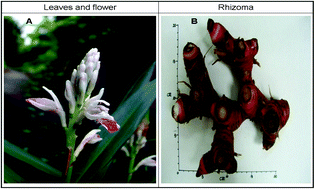Antihyperlipidemic bioactivity of Alpinia officinarum (Hance) Farw Zingiberaceae can be attributed to the coexistance of curcumin, polyphenolics, dietary fibers and phytosterols
Abstract
Rhizoma A. officinarum (Hance) Farw, synonymously is called rhizoma galangae or smaller galangal (hereafter abbreviated as AO). Numerous studies reported that AO possesses anti-inflammatory, anticancer, chemoprotective, antibacterial, antifungal and diuretic properties. To understand whether AO exhibits antihyperlipidemic bioactivity and what is the mechanism of action, we performed chemical and animal studies using hamsters (age: 4 weeks, body weight: 45 ± 4 g). The grouping of the animals was as follows: control, high fat (HF) diet, HF + AO2%, HF + AO4%, HF + AO6%, HF + AO8% and HF + AO10%. AO contained curcumin 5.67 mg g−1 (on wet basis), crude fiber 1.3% ± 0.0%, soluble diet fiber 92 ± 2 mg g−1, insoluble diet fiber 502 ± 5 mg g−1, and phytosterols 63.9 ± 1.6 mg/100 g. Its methanolic extract consisted of high polyphenolics 4927.8 ± 101.1 mgGAE/100 g and flavonoids 593.2 ± 22.2 mgQE/100 g. The enlarged organs, including liver, kidney, and spleen, which were elicited by HF were completely alleviated by AO supplement diets. Levels of serum cholesterol, triglyceride, LDL-C, HDL-C and LDL-C/HDL-C ratio for the control originally were 138 ± 6, 98 ± 4, 40 ± 5, 168 ± 7 mg dL−1 and 0.24, which were elevated by HF to 319 ± 12, 223 ± 13, 108 ± 11, 194 ± 6 mg dL−1 and 0.05, and alleviated completely by HF + AO8% and HF + AO10%. In vitro, AO extracts showed potent DPPH free radical-scavenging and superoxide anion scavenging capabilities. In vivo, AO (at dose ≥8%) dose-dependently alleviated levels of superoxide dismutase, catalase, GSH, and MDA to 117 ± 6.9 U mL−1, 32.9 ± 3.7 U mL−1, 7.0 ± 1.7 μmol mL−1 and 1.8 ± 0.4 nmol L−1, respectively, exhibiting the remarkable antioxidative and antihyperlipidemic effects of AO. Conclusively, we are the first to report the occurrence of curcumin in rhizoma A. officinarum. Curcumin synergistically elicits promising anti-dyslipidemic bioactivity with coexisting total polyphenolics, dietary fibers and phytosterols.


 Please wait while we load your content...
Please wait while we load your content...